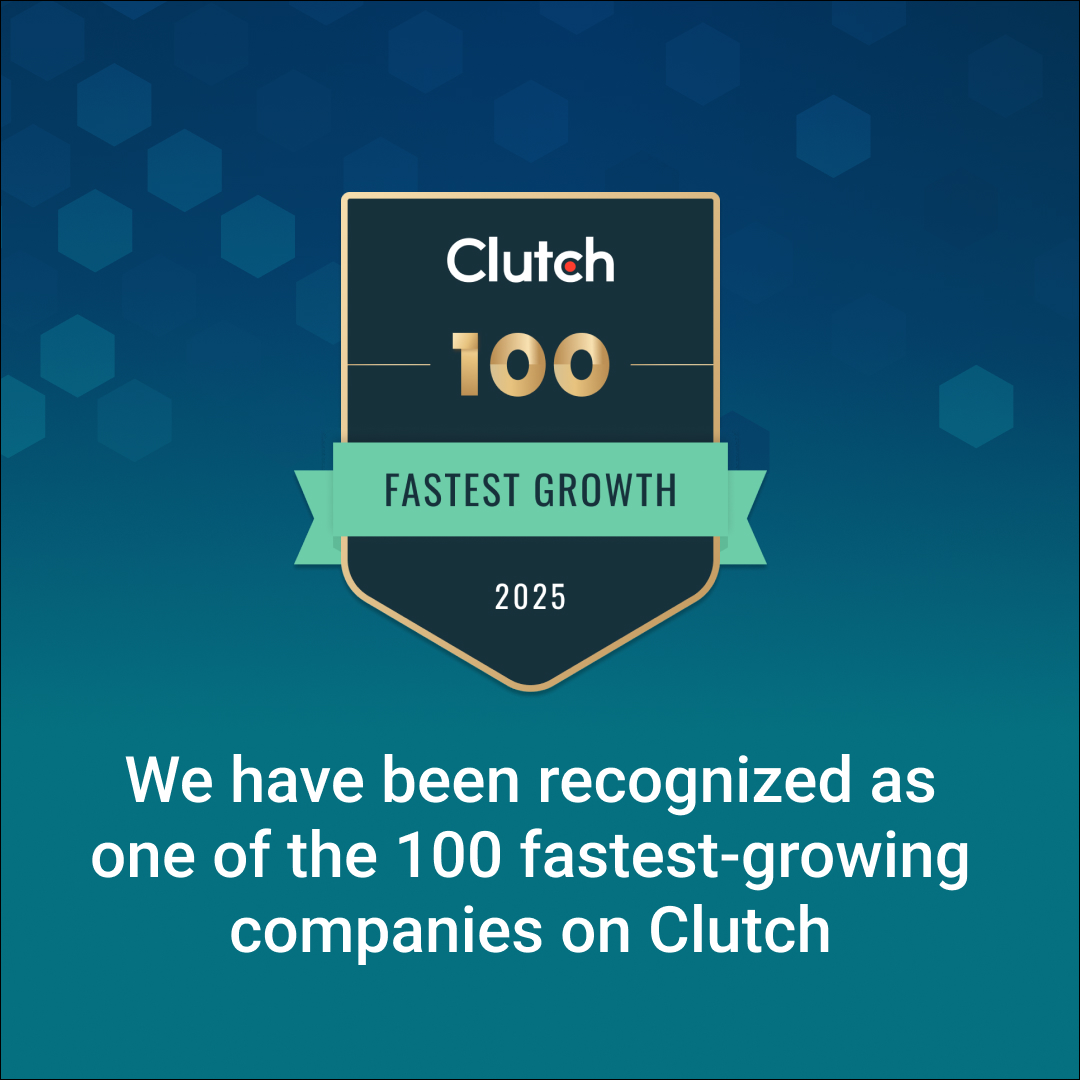Introduction
Agriculture faces mounting challenges, from unpredictable weather patterns and soil degradation to increasing demand for higher yields and sustainable practices. AI is revolutionizing the sector by enabling precise farming, optimizing resource use, and enhancing decision-making processes.
This guide explores how AI-driven innovations are reshaping agriculture into a more efficient, resilient, and data-driven industry.
What is AI and Why Does It Matter in Agriculture?
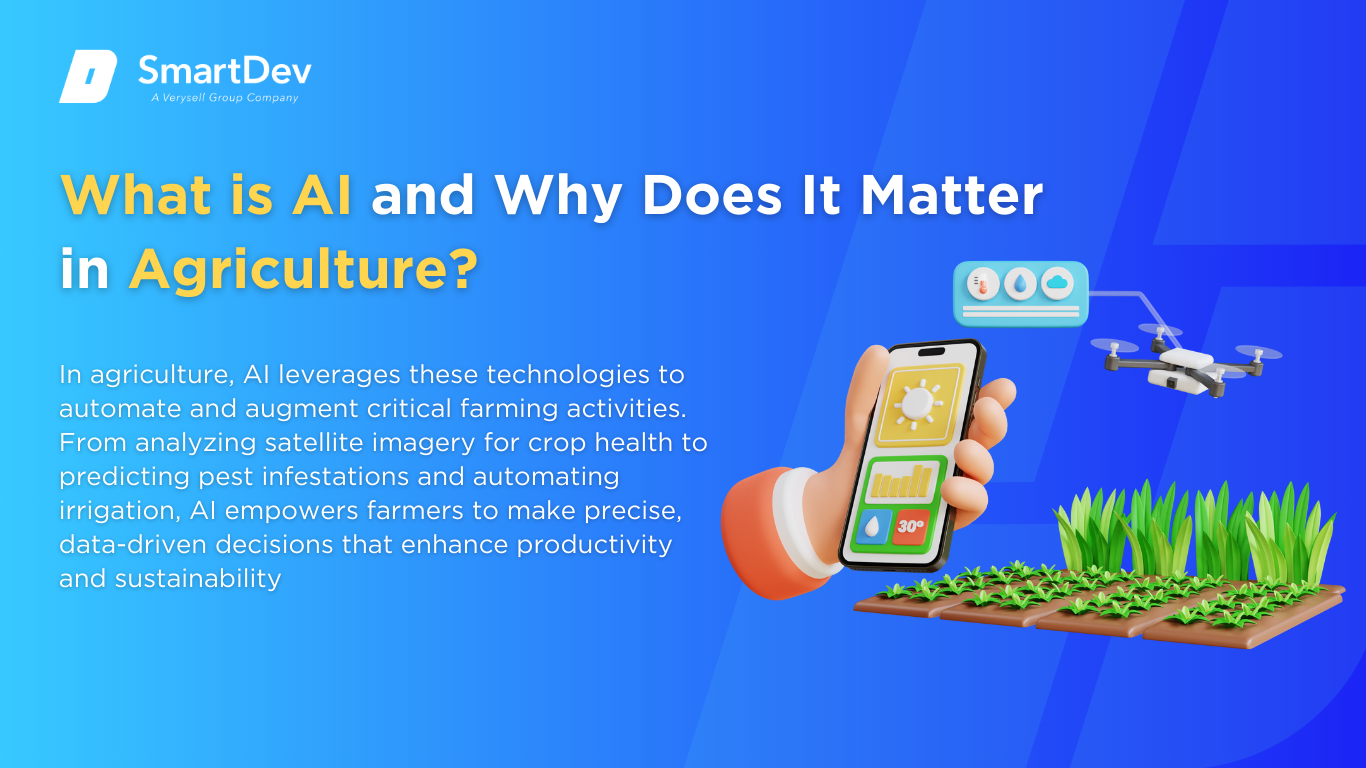
Definition of AI and Its Core Technologies
Artificial Intelligence (AI) refers to computer systems designed to perform tasks that typically require human intelligence, such as learning, reasoning, problem-solving, and decision-making. According to IBM, AI encompasses technologies like machine learning, natural language processing (NLP), and computer vision, enabling machines to interpret and act on data with human-like intelligence.
In agriculture, AI leverages these technologies to automate and augment critical farming activities. From analyzing satellite imagery for crop health to predicting pest infestations and automating irrigation, AI empowers farmers to make precise, data-driven decisions that enhance productivity and sustainability.
The Growing Role of AI in Transforming Agriculture
AI is reshaping agriculture by transforming traditional farming practices into highly optimized operations. With the integration of AI-powered drones, sensors, and predictive analytics, farmers can monitor crop conditions in real-time, detect diseases early, and reduce chemical usage, thus improving both yield quality and environmental outcomes.
The use of AI in agriculture is also enabling precision farming, where inputs like water, fertilizers, and pesticides are applied exactly where and when needed. This targeted approach reduces waste and costs while maximizing crop performance and soil health.
Moreover, AI-driven automation is tackling labor shortages by managing routine tasks such as planting, harvesting, and sorting, allowing farmworkers to focus on higher-value activities. This shift is critical in an industry facing workforce constraints worldwide.
Key Statistics and Trends Highlighting AI Adoption in Agriculture
AI adoption in agriculture is accelerating rapidly. A report by MarketsandMarkets projects that the global AI in agriculture market will grow from USD 1.7 billion in 2023 to USD 4.7 billion by 2028, reflecting a compound annual growth rate (CAGR) of 23.1% from 2023 to 2028. This growth is fueled by increasing demand for food security and sustainable farming solutions.
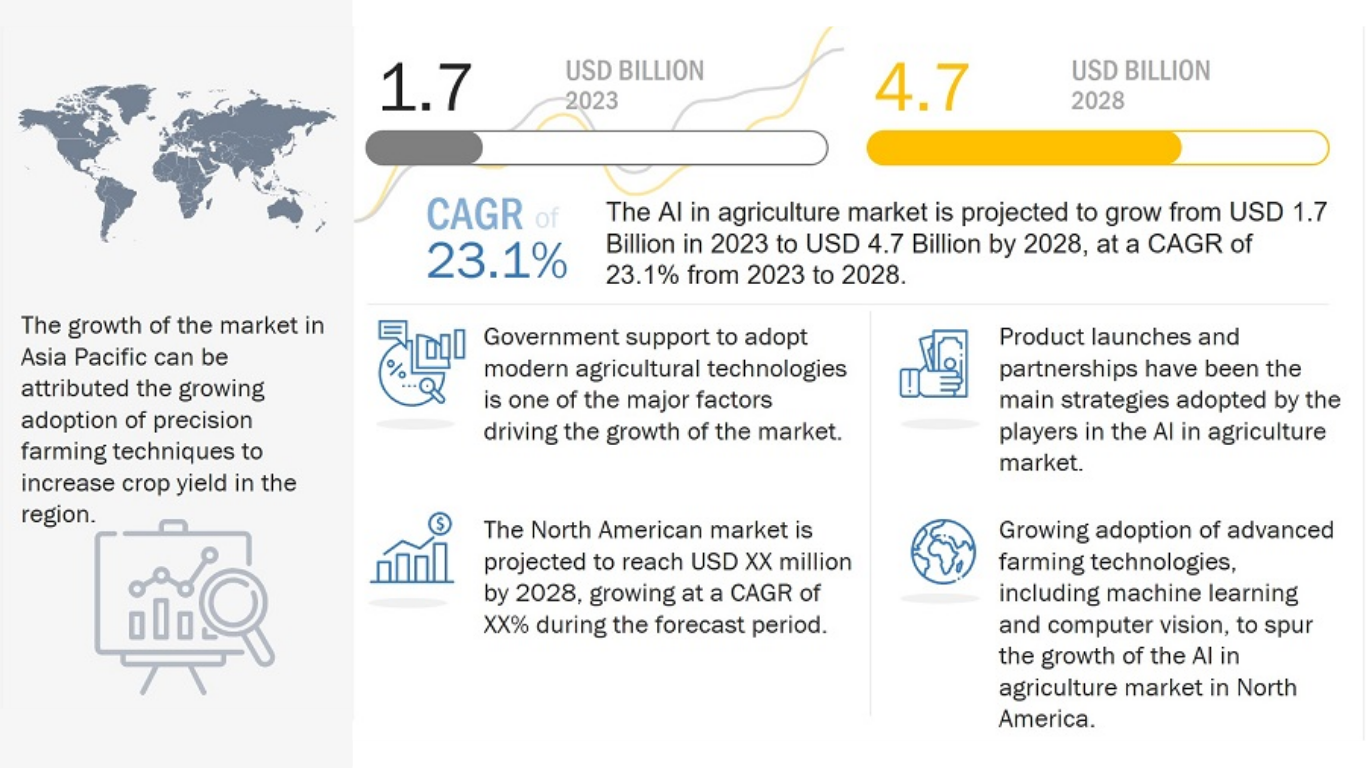
According to McKinsey, AI-powered precision agriculture can increase crop yields by 10-20% while reducing input costs by up to 15%. Early adopters of AI technologies report improved forecasting accuracy and resource efficiency, critical for coping with climate variability and market fluctuations.
Additionally, the Food and Agriculture Organization (FAO) highlights that AI-driven solutions, such as satellite monitoring and soil sensors, are becoming mainstream in large-scale farming operations globally. These technologies are integral in achieving sustainable development goals related to hunger eradication and environmental conservation.
Business Benefits of AI in Agriculture
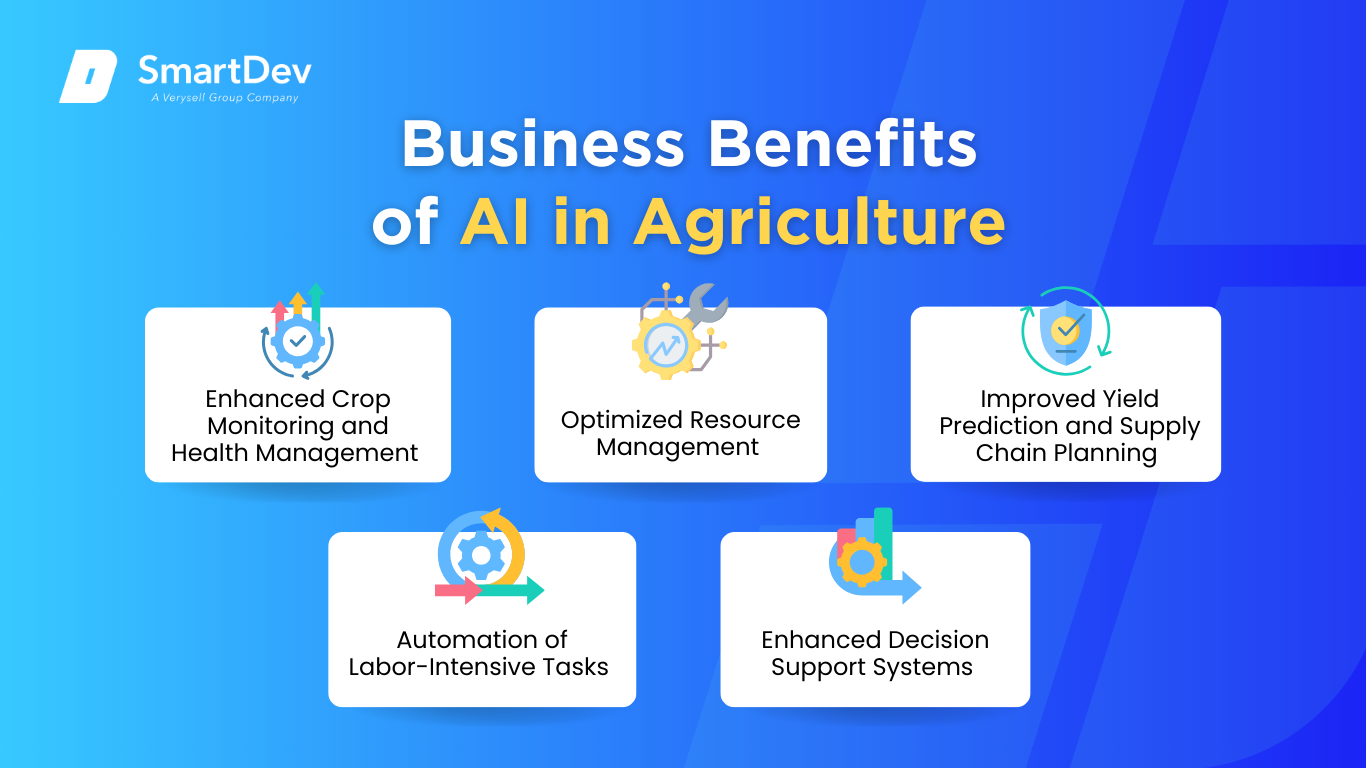
Enhanced Crop Monitoring and Health Management
AI-powered drones and satellite imagery enable continuous, high-resolution monitoring of crop conditions, providing detailed insights that were previously impossible to gather at scale. This capability allows early detection of diseases, nutrient deficiencies, and pest infestations, helping farmers take proactive measures before significant damage occurs.
Beyond detection, AI systems analyze trends over time to predict potential crop stress, allowing for precision interventions that reduce chemical use and improve crop resilience. This targeted approach not only enhances yield quality but also supports more sustainable farming practices by minimizing environmental impact.
Optimized Resource Management
AI-driven precision irrigation systems integrate real-time weather forecasts and soil moisture data to deliver water exactly when and where crops need it, significantly reducing water wastage. By tailoring irrigation schedules, these systems help conserve a vital resource and lower energy consumption associated with pumping and distribution.
Similarly, AI optimizes fertilizer application by analyzing soil health, crop type, and growth stages, ensuring nutrients are applied efficiently. This precise nutrient management prevents over-fertilization, reducing runoff pollution and input costs while maintaining optimal crop growth conditions.
Improved Yield Prediction and Supply Chain Planning
AI models analyze complex variables such as weather patterns, soil conditions, and crop phenology to generate accurate yield forecasts, reducing uncertainty for farmers and agribusinesses. Reliable yield predictions enable better planning for harvesting, storage, and distribution, mitigating risks of overproduction or shortages.
These insights also improve supply chain efficiency by aligning inventory and logistics with expected production volumes, minimizing waste and ensuring fresher produce reaches markets. Such data-driven planning enhances profitability and strengthens food security at scale.
Automation of Labor-Intensive Tasks
AI-powered robotics automate repetitive, time-consuming tasks like seeding, weeding, and harvesting, addressing labor shortages that increasingly challenge the agriculture sector. Autonomous machines operate with precision and consistency, improving operational efficiency and reducing human error in critical processes.
This automation allows farm workers to shift focus from manual labor to supervisory and analytical roles, fostering skill development and improving job satisfaction. In the long term, scalable automation supports increased production without proportionate labor cost increases, benefiting farm economics.
Enhanced Decision Support Systems
AI integrates diverse data sources like climate, soil, and market trends into cohesive decision support platforms that present actionable insights to farmers. These systems help optimize planting times, select appropriate crop varieties, and manage risk factors effectively, leading to improved farm management outcomes.
By providing predictive analytics and scenario modeling, AI tools empower farmers to simulate the impacts of different strategies, enabling more informed decisions under uncertainty. This data-driven approach reduces guesswork, increases adaptability, and maximizes profitability in an unpredictable environment.
Challenges Facing AI Adoption in Agriculture
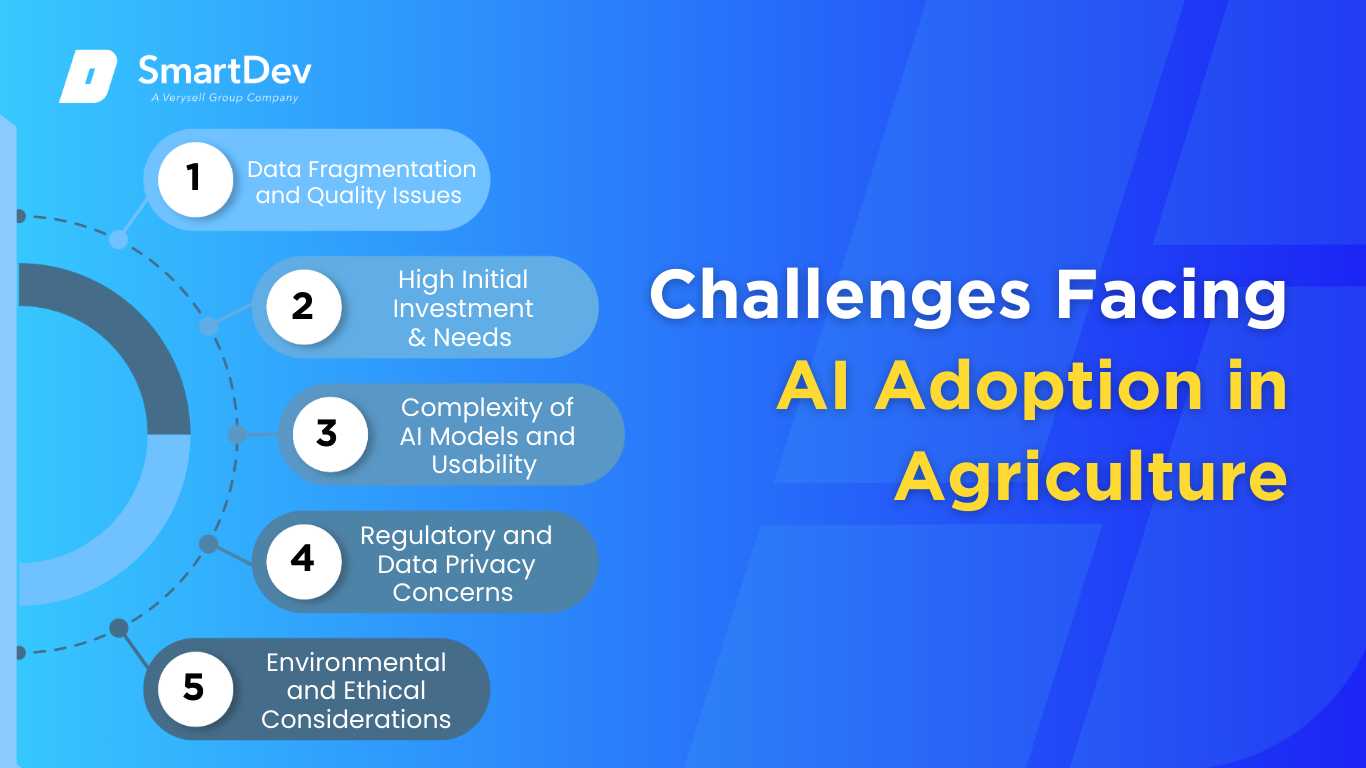
Data Fragmentation and Quality Issues
Agricultural data often comes fragmented from various sources such as IoT sensors, satellite imagery, and weather reports, resulting in inconsistent and siloed datasets. When data is disjointed or inaccurate, AI systems struggle to generate reliable insights and predictions, limiting their effectiveness in decision-making and automation.
Standardizing and integrating data requires strong collaboration among stakeholders, including farmers, technology providers, and regulators. This is not only a technical challenge but also a matter of data governance and accountability to maintain data accuracy and timeliness.
High Initial Investment and Infrastructure Needs
Deploying AI solutions in agriculture demands substantial upfront investment in hardware like drones, sensors, robotics, and supporting infrastructure such as reliable internet and cloud computing platforms. This poses significant barriers for small-scale farms and rural areas with limited financial resources and connectivity.
Additionally, without clear short-term ROI, many farmers hesitate to invest in AI technologies. Financial incentives, flexible service models, or leasing options are crucial to lower financial barriers and encourage adoption among diverse farming operations.
Complexity of AI Models and Usability
AI platforms often require specialized knowledge to operate and interpret results, creating barriers for farmers without technical backgrounds. Complex interfaces and jargon-heavy outputs can overwhelm users, leading to underutilization or incorrect application of AI tools.
To overcome this, solutions must prioritize user-centric design and provide contextualized training and support. Tailored interfaces that translate data into actionable, easy-to-understand recommendations are key to driving widespread adoption and impact.
Regulatory and Data Privacy Concerns
Data privacy and ownership issues pose significant challenges as AI depends on collecting vast amounts of sensitive farm and personal data. Ambiguous or underdeveloped legal frameworks around agricultural data can foster mistrust and reluctance to share information necessary for AI to function effectively.
Establishing clear, transparent regulations that protect data rights while enabling innovation is critical. Without these safeguards, adoption risks being stifled by fear of misuse or exploitation of sensitive information, hindering collaborative data ecosystems.
Environmental and Ethical Considerations
While AI can enhance sustainable farming practices, unchecked reliance on automation risks disrupting ecological balances, such as through monoculture reinforcement or biodiversity loss. There is also a danger that traditional farming knowledge and community roles may be marginalized by technology-driven methods.
Addressing these concerns requires embedding ethical principles and sustainability guidelines into AI development, ensuring technology complements rather than replaces local expertise. Responsible AI deployment must promote environmental stewardship and equitable benefits to farming communities.
Specific Applications of AI in Agriculture
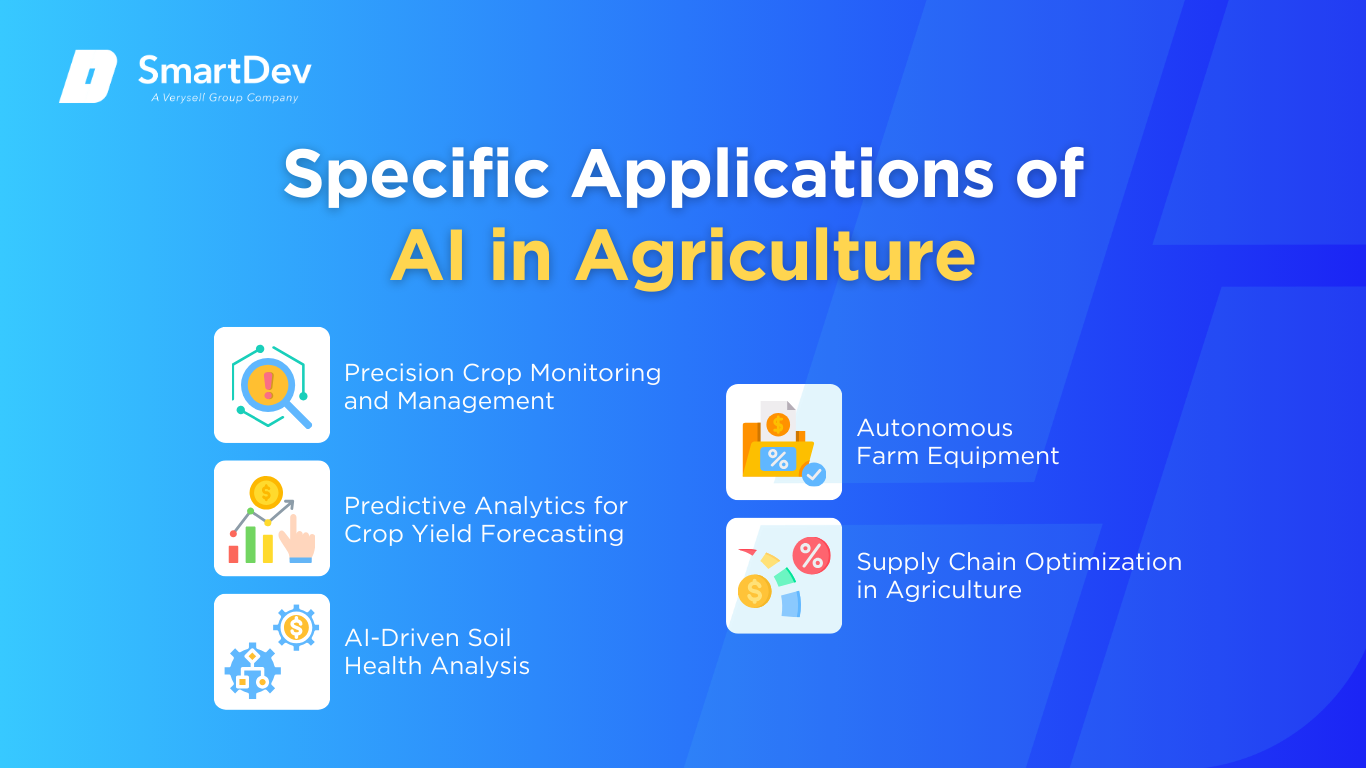
1. Precision Crop Monitoring and Management
Precision crop monitoring uses AI-powered sensors, drones, and satellite imagery to track crop health and growth in real time. This technology solves the challenge of inefficient manual monitoring and enables timely interventions for pests, diseases, and nutrient deficiencies. AI algorithms analyze multispectral data to detect early signs of stress, helping farmers optimize irrigation, fertilization, and pesticide application.
AI models rely on computer vision and machine learning methods, processing vast datasets from IoT devices and remote sensing. The integration into farm management systems allows seamless decision-making support, reducing input waste and maximizing yields. This approach offers strategic value by increasing productivity, lowering operational costs, and minimizing environmental impact.
John Deere’s “See & Spray” system uses AI-powered computer vision to differentiate crops from weeds in real time, allowing precise herbicide application only where needed. This technology reduced herbicide usage by up to 90%, significantly lowering chemical costs and environmental impact while increasing crop yields due to less collateral damage. The system integrates edge computing on tractors, enabling immediate decision-making without relying on cloud connectivity, which improves efficiency and scalability
2. Predictive Analytics for Crop Yield Forecasting
Predictive analytics uses AI models to forecast crop yields based on historical data, weather patterns, soil conditions, and crop health indicators. This application tackles the uncertainty in yield prediction that impacts supply chain planning and market pricing. Machine learning algorithms analyze multidimensional data sets to produce accurate forecasts.
The models use time-series data, satellite imagery, and agronomic variables, integrating into decision support systems for farmers and agribusinesses. The strategic value lies in enabling proactive resource allocation, risk mitigation, and improved market strategies through accurate yield predictions. Data privacy and model generalization across different regions are key technical considerations.
IBM Watson Decision Platform aggregates diverse datasets: satellite imagery, weather, and soil sensors using machine learning models to forecast crop yields with 15-30% improved accuracy. These insights enable proactive irrigation and resource allocation, reducing water use by up to 20% while optimizing overall farm productivity. The platform’s predictive analytics enhance supply chain planning and risk mitigation, leading to measurable operational efficiencies.
3. AI-Driven Soil Health Analysis
AI-driven soil health analysis uses machine learning to interpret soil sample data, identifying nutrient imbalances and contamination risks. This application solves the problem of inefficient soil testing and nutrient management that can lead to reduced crop productivity. AI models predict soil conditions and recommend customized fertilization plans.
The process involves analyzing chemical, physical, and biological soil parameters through AI algorithms trained on large datasets. Integration with IoT soil sensors provides real-time data for dynamic management. The operational benefit includes improved soil fertility, reduced environmental degradation, and cost-effective nutrient use.
Trace Genomics applies AI to soil microbiome sequencing, providing farmers with detailed insights on microbial populations that impact soil fertility and plant health. This data-driven approach guides customized amendments that improve soil conditions, leading to yield increases of up to 25% while reducing fertilizer overuse. The platform enhances sustainable farming practices by enabling precise nutrient management tailored to the specific microbial ecosystem.
4. Autonomous Farm Equipment
Autonomous farm equipment like tractors and sprayers use AI for navigation, task execution, and performance monitoring. This application addresses labor scarcity and improves operational precision. AI algorithms process GPS, LiDAR, and sensor data to enable self-driving farm machinery.
The integration with farm management software allows remote control and task scheduling, increasing efficiency. The operational value includes reduced labor dependence, lower fuel consumption, and improved accuracy of fieldwork. Safety and regulatory compliance are important considerations.
Case IH and John Deere’s autonomous tractors utilize AI algorithms combining GPS and LiDAR for precise navigation and task execution, eliminating the need for human operators in routine farming activities. These tractors increase field coverage by 20%, reduce fuel consumption by 10%, and allow remote task scheduling, boosting efficiency and reducing labor costs. The technology ensures consistent field operations and lowers operator fatigue, delivering measurable productivity gains.
5. Supply Chain Optimization in Agriculture
AI enhances agricultural supply chains by forecasting demand, optimizing logistics, and reducing food waste. This application solves inefficiencies in farm-to-market distribution that cause losses and increase costs. Machine learning models analyze market trends, weather forecasts, and inventory levels to streamline supply chain operations.
The models require data from multiple stakeholders including farmers, distributors, and retailers, integrating into supply chain management platforms. Strategic benefits include cost savings, improved delivery times, and enhanced product freshness. Data sharing and interoperability across systems remain technical challenges.
IBM’s Food Trust platform uses AI and blockchain to analyze supply chain data, optimizing logistics and improving produce traceability from farm to retailer. This integration reduces post-harvest losses by 10-15% and improves delivery times by 20%, cutting costs and enhancing freshness. By providing transparent, data-driven supply chain management, it strengthens operational resilience and consumer trust.
Examples of AI in Agriculture
Real-World Case Studies
The specific AI applications described above are transforming agriculture through measurable impacts in productivity and sustainability. This section presents real-world case studies demonstrating how companies have successfully integrated AI in their agricultural operations, offering practical insights into benefits and challenges.

Bayer: Enhancing Crop Protection with AI-Powered Decision Support
Farmers often face difficulties identifying the optimal timing and dosage for crop protection treatments, risking either overuse or ineffective application of pesticides. This challenge leads to increased costs, environmental harm, and lower yields. Precise, timely decisions are crucial to maintain crop health and sustainability.
Bayer developed the digital platform Xarvio, which uses AI to analyze weather, satellite data, and agronomic models to provide farmers with real-time, field-specific recommendations for disease and pest management. Its AI algorithms forecast risks and suggest optimal treatment windows, enabling data-driven decisions integrated directly into farm workflows. This platform also uses machine learning to continually improve recommendations based on collected data.
Xarvio users reported a 15-25% reduction in fungicide and pesticide applications while maintaining or improving yields, reducing costs and environmental footprint significantly. Bayer’s platform has been adopted globally, helping thousands of farmers optimize crop protection strategies with data-backed confidence.
Climate Corporation: Revolutionizing Farm Planning through AI Analytics
Unpredictable weather patterns and complex soil variability create significant risks for farmers in planning planting schedules and resource allocation. Traditional methods often lack the precision needed to maximize output under these variable conditions. Farmers require actionable insights that can adapt dynamically to changing environments.
The Climate Corporation’s Climate FieldView platform leverages AI and big data to analyze soil health, weather forecasts, and historical yield data to optimize planting decisions and input application. The platform provides granular, field-level insights and real-time monitoring, allowing farmers to tailor practices to micro-environmental conditions. Machine learning continuously refines models, increasing predictive accuracy over time.
Farmers using FieldView have achieved yield gains of 5-10% and reduced input costs by up to 15% due to improved resource targeting. The platform also enhances risk management by helping farmers adapt planting and input strategies to weather volatility, improving resilience.
Corteva Agriscience: AI-Driven Seed Breeding for Climate Resilience
The agriculture industry faces mounting pressure from climate change, with droughts, floods, and temperature extremes threatening crop viability. Traditional seed breeding processes are time-consuming and often unable to keep pace with these rapid environmental changes. Innovative approaches are required to develop resilient crop varieties efficiently.
Corteva Agriscience employs AI and machine learning to accelerate seed breeding by analyzing genetic, phenotypic, and environmental data to identify traits linked to climate resilience. Their AI-powered platforms simulate breeding outcomes, enabling targeted development of seeds that perform better under stress conditions. This approach reduces trial-and-error cycles and speeds up time-to-market for improved seed varieties.
Corteva reports that AI-enhanced breeding has increased the speed of developing drought-tolerant corn and soybean varieties by up to 50%, enabling farmers to maintain yields despite adverse weather. These innovations support global food security efforts by delivering robust crops faster.
Apeel Sciences: Extending Fresh Produce Shelf Life with AI-Optimized Coatings
Post-harvest loss of fruits and vegetables due to spoilage poses a significant challenge, causing waste and reducing farmer revenues. Traditional preservation methods often involve cold storage, which can be costly and energy-intensive. There is a need for scalable, sustainable solutions to prolong produce freshness.
Apeel Sciences developed an edible coating made from plant-derived materials to slow down moisture loss and oxidation, effectively extending the shelf life of produce. AI algorithms optimize the coating formulations and application processes by analyzing produce characteristics and environmental factors. This data-driven approach enables customized coatings that maximize freshness retention for various fruits and vegetables.
Apeel’s coatings have been shown to extend shelf life by 50% or more, reducing food waste and increasing marketability. Retailers and farmers benefit from reduced spoilage, longer shipping windows, and higher-quality produce reaching consumers.
Innovative AI Solutions
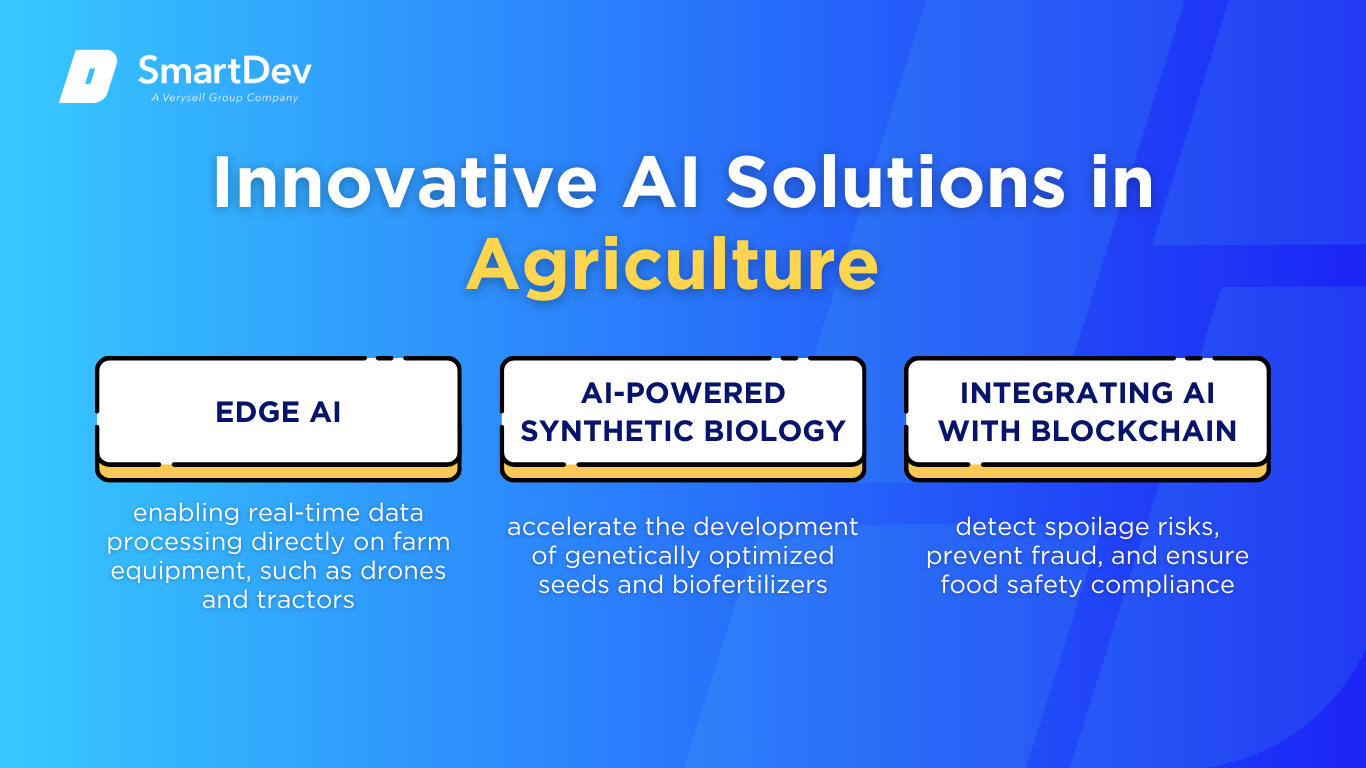
Emerging AI technologies like edge AI are transforming agriculture by enabling real-time data processing directly on farm equipment, such as drones and tractors. This reduces reliance on cloud connectivity, allowing immediate responses to dynamic conditions like pest outbreaks or moisture changes. Faster decision-making on-site improves resource efficiency and minimizes crop damage.
AI-powered synthetic biology accelerates the development of genetically optimized seeds and biofertilizers by analyzing vast genetic and environmental data. This technology shortens breeding cycles and creates tailored solutions that boost crop resilience and yield without expanding farmland. These innovations support sustainable farming by reducing the need for chemical inputs.
Integrating AI with blockchain enhances supply chain transparency by tracking produce from farm to table with immutable records. AI analyzes this data to detect spoilage risks, prevent fraud, and ensure food safety compliance. This combination strengthens consumer trust and reduces losses, improving overall supply chain efficiency.
AI-Driven Innovations Transforming Agriculture
Emerging Technologies in AI for Agriculture
Generative AI is increasingly playing a transformative role in agriculture, especially in optimizing crop planning and farm management strategies. By analyzing vast datasets including weather patterns, soil conditions, and crop health metrics, generative AI models can simulate multiple planting scenarios to recommend optimal crop rotations or precision planting schedules.
Computer vision technologies have become indispensable for modern agriculture by providing detailed, real-time analysis of crops and livestock through aerial drones, satellite imagery, and ground-based sensors. AI-powered image recognition systems can detect early signs of disease, pest infestations, or nutrient deficiencies far more quickly and accurately than manual inspection.
AI’s Role in Sustainability Efforts
In agriculture, reducing waste is not just a cost-saving measure but a critical factor for sustainable food production. AI-powered predictive analytics analyze historical and real-time data such as weather forecasts, soil moisture levels, and crop growth patterns to optimize irrigation, fertilization, and harvesting schedules. This data-driven approach helps farmers avoid overuse of resources and minimizes crop losses due to unforeseen environmental changes, leading to significant reductions in waste and input costs.
Energy efficiency is a growing concern in agricultural operations, especially with the increasing mechanization and use of climate-controlled environments such as greenhouses. AI-driven smart systems optimize energy use by dynamically adjusting machinery operation, irrigation pumps, and climate controls based on sensor inputs and predictive algorithms. For example, AI can determine the exact times and amounts for irrigation, reducing water and electricity consumption significantly.
How to Implement AI in Agriculture
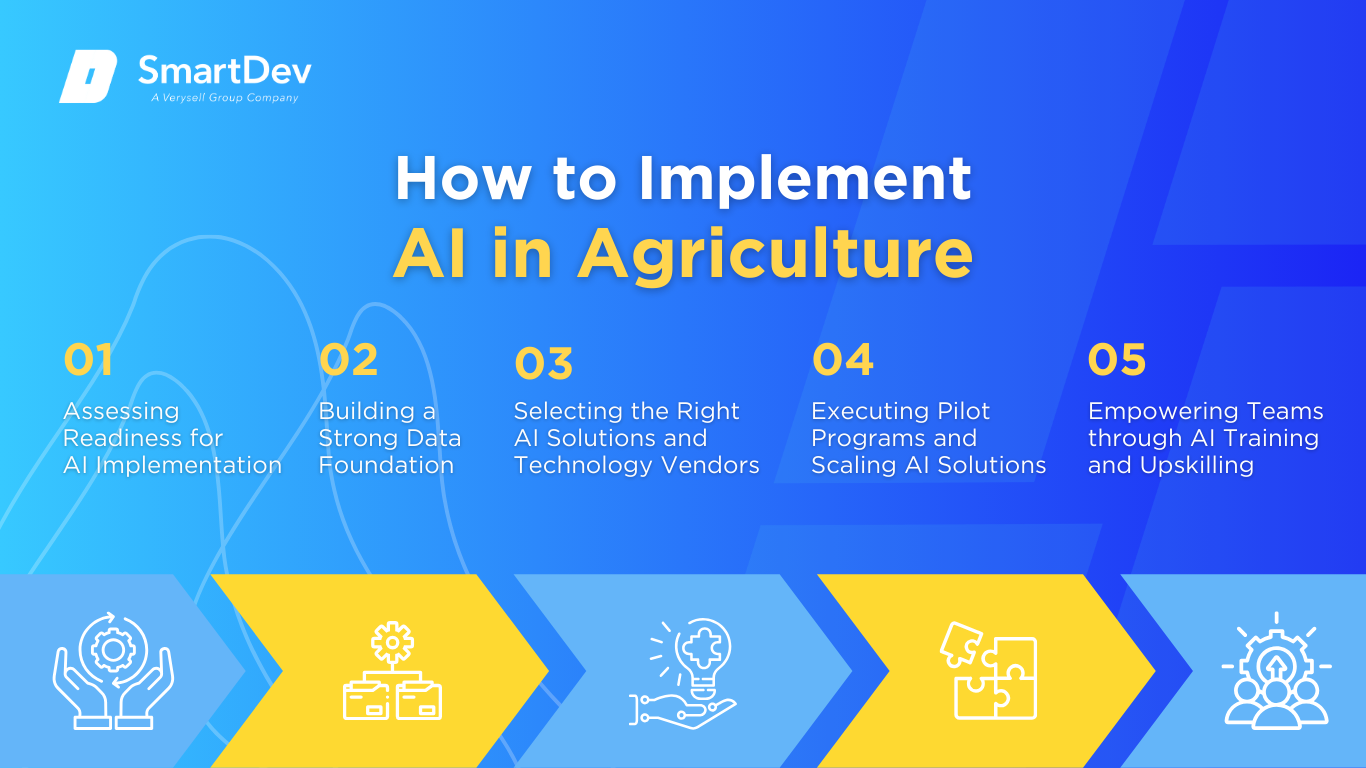
Step 1: Assessing Readiness for AI Adoption
Before diving into AI adoption, agricultural businesses must thoroughly assess their readiness by evaluating existing infrastructure and operational workflows. This means identifying specific farm operations that can benefit most from AI integration. Understanding current challenges and pinpointing processes where AI can deliver measurable improvements ensures focused investment and prevents costly trial-and-error.
Step 2: Building a Strong Data Foundation
Data is the lifeblood of AI, making the collection, cleaning, and management of agricultural data paramount. Farms must deploy sensors, drones, and satellite systems to capture comprehensive datasets covering soil health, weather conditions, crop growth stages, and pest activity. Equally important is establishing processes to clean and normalize this data to eliminate errors and inconsistencies, which can otherwise skew AI predictions.
Step 3: Choosing the Right Tools and Vendors
Partnering with vendors who offer modular, customizable AI solutions allows farms to start small and expand capabilities gradually. Furthermore, choosing vendors with strong local support and understanding of regulatory landscapes ensures smoother adoption and compliance. Strategic vendor relationships empower agricultural businesses to leverage AI innovations effectively while minimizing risks.
Step 4: Pilot Testing and Scaling Up
Starting with pilot projects allows farms to validate AI applications on a small scale, testing their impact under real-world conditions. For example, a pilot might focus on AI-driven irrigation scheduling in one field to measure water savings and crop health improvements. These trials help identify technical or operational challenges and inform necessary adjustments before wider rollout.
Step 5: Training Teams for Successful Implementation
Human expertise remains vital in the AI transformation journey. Training farm workers, agronomists, and managers to understand and collaborate with AI tools fosters trust and maximizes technology benefits. Upskilling programs should focus on digital literacy, interpreting AI insights, and integrating recommendations into daily decision-making.
Measuring the ROI of AI in Agriculture
Key Metrics to Track Success
To quantify AI’s return on investment in agriculture, businesses must track metrics that reflect both operational efficiency and sustainability. Yield improvements serve as a direct indicator of AI’s impact on productivity, while reductions in water, fertilizer, and pesticide usage reflect cost savings and environmental benefits. Monitoring these alongside input costs gives a balanced view of financial returns.
Additionally, metrics like decreased crop loss due to pests or diseases, improved supply chain efficiency, and enhanced forecasting accuracy contribute to a comprehensive ROI assessment. These factors not only affect profitability but also help build resilience against climate variability and market fluctuations, underscoring AI’s strategic value.
Case Studies Demonstrating ROI
Several pioneering agricultural enterprises have realized impressive ROI by integrating AI technologies. For instance, a large-scale farm in California implemented AI-powered precision irrigation that reduced water consumption by 30% while increasing crop yield by 15%. This translated into substantial cost savings and boosted revenue, with the system paying for itself within two growing seasons.
Another case involves a European agribusiness that adopted AI-based pest prediction models, enabling targeted pesticide applications. This approach lowered chemical usage by 25%, significantly cutting input costs and minimizing environmental impact. The resulting improvements in crop quality and regulatory compliance further enhanced market access and profitability, showcasing AI’s multifaceted ROI.
Common Pitfalls and How to Avoid Them
One common challenge in AI adoption is overestimating initial outcomes due to unrealistic expectations or poor alignment with farm operations. Many agricultural businesses fail to establish clear KPIs or neglect the need for iterative model refinement, which can lead to disappointing ROI. To avoid this, it’s essential to set achievable goals, monitor progress closely, and adjust strategies based on data-driven insights.
Data quality issues also frequently hamper AI effectiveness. Incomplete or inaccurate data can result in misleading predictions, eroding trust in AI systems. Implementing rigorous data validation processes and maintaining transparent communication with stakeholders can mitigate these risks. Lastly, neglecting workforce engagement often slows AI uptake, addressing human factors early fosters smoother transitions and better returns.
Future Trends of AI in Agriculture

Predictions for the Next Decade
The next decade will witness AI becoming an indispensable component of smart farming, with technologies evolving to provide hyper-localized insights and autonomous decision-making. Edge AI, which processes data directly on farm devices, will enable faster, more reliable responses to environmental changes without relying on cloud connectivity. This will facilitate real-time adjustments in irrigation, fertilization, and pest control, optimizing resource use and boosting sustainability.
Furthermore, AI integration with robotics will expand, allowing for autonomous planting, harvesting, and field monitoring at unprecedented scales. Advances in genomic AI will also accelerate crop breeding programs, enabling the development of resilient, high-yield varieties tailored to specific climates. These innovations will transform agriculture into a highly precise, adaptive industry equipped to meet global food security challenges.
How Businesses Can Stay Ahead of the Curve
To stay competitive, agricultural enterprises must adopt a proactive approach toward technology scouting and continuous innovation. Engaging in collaborative networks with research institutions, technology providers, and fellow farmers will accelerate knowledge exchange and technology transfer. Staying abreast of regulatory changes and sustainability standards ensures compliance and market advantage.
Investing in workforce development is equally critical, as skilled personnel will be essential to harness AI’s full potential. Businesses should foster flexible, data-driven cultures where experimentation is encouraged and failures viewed as learning opportunities. By embracing these principles, agricultural organizations can future-proof operations and capitalize on emerging AI-driven opportunities.
Conclusion
Key Takeaways
AI is revolutionizing agriculture by enabling precision farming, resource optimization, and sustainability improvements. Key applications include generative AI for crop planning, computer vision for crop and livestock monitoring, and predictive analytics for reducing waste. Successful AI adoption relies on a strong data foundation, careful technology selection, pilot testing, and workforce training to maximize benefits.
Measuring ROI through yield gains, cost savings, and environmental impact helps validate investments and refine AI strategies. Despite challenges like data quality and workforce adaptation, AI offers a transformative pathway for agriculture to increase productivity and resilience amid growing global demands.
Moving Forward: A Path to Progress
AI in agriculture is quickly becoming a vital driver of productivity, sustainability, and profitability in today’s dynamic farming landscape. By investing now in data readiness, building AI literacy across your teams, and selecting scalable, agriculture-focused AI solutions, you can unlock unprecedented efficiency, resource optimization, and crop quality improvements.
At SmartDev, we partner with agricultural leaders to navigate the AI transformation with customized solutions that address real-world farming challenges. From precision crop management and predictive pest control to automated irrigation and supply chain optimization, our experts deliver AI-driven tools designed to create measurable impact and long-term value.
Contact us today to discover how we can help you harness the power of AI to transform your agricultural operations. Together, let’s grow a smarter, more resilient, and sustainable future for your farm and the food industry.
—
References:
- AI in Agriculture Market | MarketsandMarkets
- AI in Agriculture: Enhancing Productivity and Sustainability | Boston Institute of Analytics
- The State of Food and Agriculture 2022 | FAO
- Harvesting Tomorrow: New Ideas and Changes in the Agricultural Robots Market | Global AgTech Initiative
- IBM Watson Studio | IBM
- Innovation in Soil Intelligence | Trace Genomics
- iFoodDS and IBM Forge New Path to Food Safety with IBM Food Trust | IBM
- China Approves First AI Agricultural Robot | AgroPages
- AI Can Transform Crop Protection | AgFunder News
- Apeel Sciences’ Edible Coating: Extending Shelf Life Sustainably | SGS Digicomply


